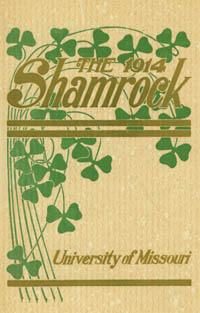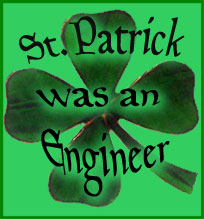A History of the College
of Engineering at the
University of Missouri - Columbia

Mechanical Engineers, ca. 1968
(University Archives, C:9/13/1).
History
Engineering at the University of Missouri-Columbia has a rich history and colorful traditions. Education in Engineering got an early start at the University. When William W. Hudson was appointed Chair of Civil Engineering, it was only three years after the first Civil Engineering program was established in the country. Engineering education received greater support with passing of the Morill Act in 1862. However, since the University's sessions were disrupted by the Civil War, effects were not felt until the 1870's. It was at this time that the General Assembly approved a College of Agriculture and Mechanic Arts. In 1877, the School of Engineering gained independence from the College of Agriculture under the leadership of Thomas J. Lowry. Upon his retirement, Engineering was placed under Agriculture again. In 1906, Engineering reclaimed the status of "College", which it now holds.
There were many notable firsts in the history of the College of Engineering at the University of Missouri-Columbia. The College boasts the first Engineering course taught west of the Mississippi River in 1849, only ten years after the University became the first institution of higher learning west of the Mississippi. In 1883, Thomas Edison donated a dynamo to the college, and incandescent lighting was demonstrated for one of the first times on the Mississippi's western frontier. Mizzou Engineering pioneered one of the first Electrical Engineering programs in the country. Soon after receiving Edison's dynamo, Academic Hall, the University's main building, became the first building in Columbia to receive electric lighting, wired by Professor Benjamin E. Thomas and his engineering students. Ironically, the result of this pioneering effort ended in calamity. In 1892, ten years after the first course in electrical engineering, a fire caused by electrical wiring burned Academic Hall to the ground. Weathering this tragedy, the turn of the century was a time of major building and growth for the University, and the College of Engineering was no exception. (See also the exhibit "Y1.9K: Mizzou in 1900".) Enrollment shot up steadily in these years:
|
Turn of the Century Engineering Enrollment | |
| School Year | # of Students |
| 1879-80 | 40 |
| 1898-99 | 75 |
| 1899-00 | 99 |
| 1900-01 | 130 |
| 1910-11 | 411 |
In fact, increasing numbers of students led to the re-establishment of "college" status in 1906, after having been placed under the College of Agriculture and Mechanical Arts since the retirement of Thomas Lowry in 1893.
Shortly before this, in 1903, the industrious engineers of MU became the first in the nation to "discover" that St. Patrick was an engineer and set a trend among engineering schools with the first St. Pat's Day Parade and Kowtow in 1905. For more information about the history of St. Patrick's Day celebrations at MU, click here for the St. Pat's Day Exhibit.
In 1907, thirteen years before women received the right to vote, the first woman graduated from the College of Engineering.
Enrollment peaked at 411 in 1910-1911. However, the College then took a risk by increasing the program to five years. This had the effect of decreasing enrollment to 145 by 1913-1914. In 1915, the College returned to a more traditional four year plan, and enrollment increased by 100%.
The turn of the century rise in enrollment before and after 1900 was mirrored in the years leading to the year 2000. Although engineering enrollment has decreased nationally, enrollment in Mizzou's College of Engineering has increased by 35% over the past five years. Engineering enrollment on the Columbia campus was 1,834 combined undergraduate and graduate students in the Winter semester of 2000.
Departments
- 1859 Civil Engineering
- 1868-1890 Military Engineering
- 1885 Electrical Engineering
- 1891 Mechanical Engineering
- 1903 Chemical Engineering
- 1917 Agricultural Engineering
- 1958 Industrial Engineering (later Industrial and Systems Engineering)
- 1964 Nuclear Engineering
- 1967 Aerospace Engineering (added to Mechanical)
- 1982 Computer Engineering (later Computer Science; added to Electrical)
- 1997 Biological Engineering (added to Chemical)
- 1998 Environmental Engineering (added to Civil)
Research Facilities
- Engineering Experiment Station - The Engineering Experiment Station was established in 1909 as a center for engineering research and continues to fill this important role. Results of experiments conducted have been published in the "Bulletin of the Engineering Experiment Station" (University Archives, C:9/14/2) since its inception. Activities at the station were suspended from 1931-1938 due to the financial conditions of the Great Depression. World War II also caused a cessation of research activities for a brief period.
- Engineering Library - The Engineering Library was founded in 1906. In 1937, it was moved from the main assembly room of the Engineering Building to the second floor of the Engineering Building East.
- Research Reactor - In 1962, an 85 acre tract of land one-half mile southwest of the campus football stadium was set aside for Research Park. By 1965, one year after the Nuclear Engineering Department was established, the Research Reactor and laboratories were completed. The Reactor first went critical in 1966. The role of the Reactor has expanded from simply demonstrating nuclear mechanics and the study of matter and energy to the improving medical diagnostic tools and radiopharmacology.
Leadership
- 1877-1893 Thomas J. Lowry, first Dean of Faculty for the School of Engineering
- Note: Engineering became a school under the College of Agriculture & Mechanical Arts for the next 13 years.
- 1903 Howard Burton Shaw, Junior Dean
- 1904 Frederick P. Spalding, Junior Dean
- 1905 Arthur M. Green, Junior Dean
- 1906-1913 Howard Burton Shaw, Dean
- 1913-1914 E. A. Fessenden, Acting Dean
- 1914-1935 Elmer J. McCaustland
- 1935-1938 F. Ellis Johnson
- 1938 A.C. Lanier, Acting Dean
- 1938-1948 Harry A. Curtis, Dean
- 1944-1945, 1948-1949 Harry Rubey, Acting Dean
- 1949-1962 Huber O. Croft, Dean
- 1962-1967 Joseph C. Hogan, Dean
- 1967-1969 Adrian Pauw, Acting Dean
- 1969-1986 William R. Kimel, Dean
- 1986-1993 Anthony L. Hines, Dean
- 1993-1994 James W. Baldwin, Interim Dean
- 1994-2014 James E. Thompson, Dean
- 2015-2020 Elizabeth G. Loboa, Dean
- 2020 Noah D. Manring, Interim Dean
- 2021-2023 Noah D. Manring, Dean
- 2023-2024 Praveen Edara, Interim Dean
- 2024-present Marisa Chrysochoou, Dean
Student Publications
In commemoration of the founding of St. Patrick's Day activities, the Senior class containing the last members of the first Guard of St. Patrick put together a small booklet called The Shamrock to recount the events surrounding the early celebrations. The publication soon evolved into a printed forum for engineers to contribute poems and document memories of their year at Mizzou. By the 1914 edition, The Shamrock had taken the nature of an engineering-specific yearbook with a similar layout as the contemporary Savitar, the yearbook of the University as a whole. In 1933, the Shamrock discontinued its role as a yearbook and took up the role as a general interest student bulletin and magazine, absorbing the function of what was called The Engineers Monthly Bulletin (ca. 1931-1933).

1914 copy of The Shamrock
(University Archives, C:9/13/3)
Sources & Related Links:
- College of Engineering
- University Archives C:0/51/1 - University Catalogs and Bulletins
- University Archives C:9/11/2 - College of Engineering; Printed and Duplicated Materials; History
- Weinbach, Mendell P. Engineering at the University of Missouri - 1850-1940. The Engineering Foundation: Columbia, Missouri, 1941.
[A digital copy of Weinbach's book is available here.] - Croft, Huber O. A Brief History of the College of Engineering: University of Missouri-Columbia - 1940-1967. University of Missouri-Columbia, 1968. [A digital copy of Croft's book is available here.]
- Weinbach, Mendell P. Engineering at the University of Missouri - 1850-1940. The Engineering Foundation: Columbia, Missouri, 1941.
- University Archives C:9/13/1 - Office of Engineering Communications; Memorabilia
- University Archives C:9/13/3 - Office of Engineering Communications; The Shamrock
- University Archives C:9/14/1 - Engineering Catalogs and Bulletins
- University Archives C:9/14/2 - Engineering Experiment Station Catalogs and Bulletins

